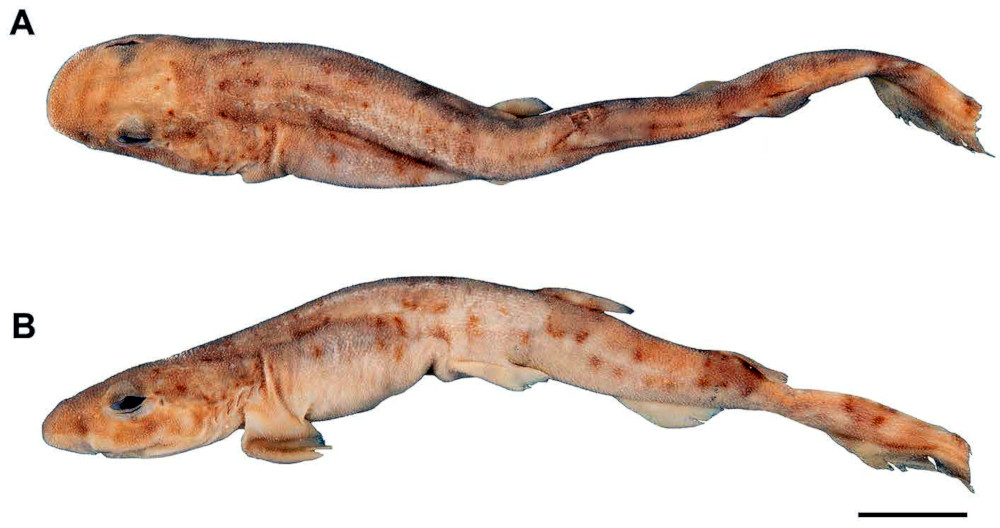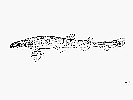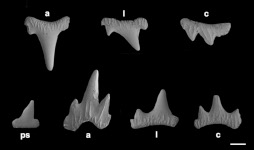Scyliorhinus boa
Goode & Bean, 1896
Boa catshark
Classification: Elasmobranchii Carcharhiniformes Scyliorhinidae
Reference of the original description
Oceanic ichthyology, a treatise on the deep-sea and pelagic fishes of the world, based chiefly upon the collections made by the steamers Blake, Albatross, and Fish Hawk in the northwestern Atlantic, with an atlas containing 417 figures. Special Bulletin U. S. National Museum, 2: Text: i–xxxv + 1–26 + 1–553, Atlas: i–xxiii, 1–26, 123 pls.
Oceanic ichthyology, a treatise on the deep-sea and pelagic fishes of the world, based chiefly upon the collections made by the steamers Blake, Albatross, and Fish Hawk in the northwestern Atlantic, with an atlas containing 417 figures. Special Bulletin U. S. National Museum, 2: Text: i–xxxv + 1–26 + 1–553, Atlas: i–xxiii, 1–26, 123 pls.
Image of the original description
No image in first description.
No image in first description.
Synonyms / new combinations and misspellings
Catulus boa, Scyliorhinus fernandezi, Scyliorhinus retifer boa , Scylliorhinus boa
Catulus boa, Scyliorhinus fernandezi, Scyliorhinus retifer boa , Scylliorhinus boa
Types
Scyliorhinus boa
Holotype: MCZ: 1335-S;
Scyliorhinus fernandezi
Holotype: MHNLS: 3052 (not MHNLS 7717, ex. AFY 149);
Scyliorhinus boa
Holotype: MCZ: 1335-S;
Scyliorhinus fernandezi
Holotype: MHNLS: 3052 (not MHNLS 7717, ex. AFY 149);
Description :
Citation: Scyliorhinus boa Goode & Bean, 1896: In: Database of modern sharks, rays and chimaeras, www.shark-references.com, World Wide Web electronic publication, Version 01/2026
Please send your images of "Scyliorhinus boa" to info@shark-references.com

Scyliorhinus boa Goode & Bean, 1896, holotype, MCZ S–1335, 149.4 mm TL, Lesser Antillean, Barbados © Karla A. Soares, Laboratório de Ictiologia, Departamento de Zoologia, Instituto de Biociências, Universidade de São Paulo

Scyliorhinus boa Goode & Bean, 1896, holotype, MCZ S–1335, 149.4 mm TL, Lesser Antillean, Barbados © Karla A. Soares, Laboratório de Ictiologia, Departamento de Zoologia, Instituto de Biociências, Universidade de São Paulo
Common names
 Alitán boa,
Alitán boa,  Gatica,
Gatica,  Roussette boa,
Roussette boa,  Boa Catshark,
Boa Catshark,  Boa cat shark,
Boa cat shark,  Cação-pinto
Cação-pinto
 Alitán boa,
Alitán boa,  Gatica,
Gatica,  Roussette boa,
Roussette boa,  Boa Catshark,
Boa Catshark,  Boa cat shark,
Boa cat shark,  Cação-pinto
Cação-pinto
Short Description
Diagnosis after Compagno, 1984 [517]: Field Marks : A moderate-sized, fairly slender catshark with rows of small black spots that outline inconspicuous saddle and flank markings but with few or no spots inside the saddles, fairly large and slender, small anterior nasal flaps that do not reach mouth, no nasoral grooves, labial furrows on lower jaw only, second dorsal fin much smaller than first. Diagnostic Features: Head and body relatively deep, slender and narrow; greatest width of head less than 2/3 of head length; no nasoral grooves; anterior nasal flaps not expanded and falling short of mouth. First dorsal origin slightly behind pelvic insertions; second dorsal origin over last half of pelvic bases; interdorsal space greater than anal base. Denticles fairly small, skin not very rough. Colour pattern of numerous small black spots about size of eye pupil or more, forming rectilinear outlines to indistinct grey saddles and flank markings that hardly contrast with the ground colour; spots sometimes forming reticulating rows, but with few or none inside saddle areas; sometimes a few white spots on dorsolateral surface. Size fairly small, to at least 54 cm.
Diagnosis after Compagno, 1984 [517]: Field Marks : A moderate-sized, fairly slender catshark with rows of small black spots that outline inconspicuous saddle and flank markings but with few or no spots inside the saddles, fairly large and slender, small anterior nasal flaps that do not reach mouth, no nasoral grooves, labial furrows on lower jaw only, second dorsal fin much smaller than first. Diagnostic Features: Head and body relatively deep, slender and narrow; greatest width of head less than 2/3 of head length; no nasoral grooves; anterior nasal flaps not expanded and falling short of mouth. First dorsal origin slightly behind pelvic insertions; second dorsal origin over last half of pelvic bases; interdorsal space greater than anal base. Denticles fairly small, skin not very rough. Colour pattern of numerous small black spots about size of eye pupil or more, forming rectilinear outlines to indistinct grey saddles and flank markings that hardly contrast with the ground colour; spots sometimes forming reticulating rows, but with few or none inside saddle areas; sometimes a few white spots on dorsolateral surface. Size fairly small, to at least 54 cm.
Distribution
Western Atlantic: Caribbean slope off Barbados, Lesser Antilles, Hispaniola, and Jamaica; also from Honduras to Colombia. Source: www.gbif.org
Western Atlantic: Caribbean slope off Barbados, Lesser Antilles, Hispaniola, and Jamaica; also from Honduras to Colombia. Source: www.gbif.org
Human uses
fisheries: of no interest
fisheries: of no interest
Dentition
Monognathic heterodonty gradual well developed; anterior teeth abruptly greater than the parasymphysial ones and lateral teeth smaller distally, with smaller and thicker principal cusps (Fig. 6). Sexual heterodonty not observed; only adult males examined. Tooth counts 19–25 20–24/17–22 1 19–24 (19–20/19–1–20). Parasymphysial teeth with a principal cusp flanked by one cusplet at each side; cusplets 1/3 height of principal cusp. Protuberances on the crown base or striae absent along the labial surface. Anterior teeth larger than the parasymphysial one and principal cusp less stout. Anterior teeth with a principal cusp and two or three cusplets. Anterior upper teeth with two cusplets on the mesial edge and a poorly developed cusplet on the distal edge; one cusplet poorly developed present on each side of the principal cusp in the lower teeth. Protuberances and striae restricted to the crown base. Lateral teeth in both jaws smaller than the anterior ones, with one principal cusp and three cusplets; principal cusp oblique in upper teeth and straight in lower ones. Mesial proximal cusplet half the height of the principal cusp, 1/3 larger than the distal cusplet and two times the mesial marginal cusplet. Protuberances on the crown base and striae running from the crown base to one half the height of the principal cusp on labial surface. Commissural teeth similar to the anterior ones in number of cusplets. Principal cusp stronger, inclined toward the commissure in upper teeth and nearly straight in lower ones; two cusplets at the mesial edge and one at the distal edge. Mesial proximal and distal cusplets 2/3 the height of the principal cusp and half of its width. Mesial marginal cusplet poorly developed and corresponding to half the height of the mesial proximal cusplet. Protuberances present and striae running from the base toward the apex of the crown on the labial surface. Ectodermal pits present on lateral and commissural teeth, restricted to the crown base [27296]
Monognathic heterodonty gradual well developed; anterior teeth abruptly greater than the parasymphysial ones and lateral teeth smaller distally, with smaller and thicker principal cusps (Fig. 6). Sexual heterodonty not observed; only adult males examined. Tooth counts 19–25 20–24/17–22 1 19–24 (19–20/19–1–20). Parasymphysial teeth with a principal cusp flanked by one cusplet at each side; cusplets 1/3 height of principal cusp. Protuberances on the crown base or striae absent along the labial surface. Anterior teeth larger than the parasymphysial one and principal cusp less stout. Anterior teeth with a principal cusp and two or three cusplets. Anterior upper teeth with two cusplets on the mesial edge and a poorly developed cusplet on the distal edge; one cusplet poorly developed present on each side of the principal cusp in the lower teeth. Protuberances and striae restricted to the crown base. Lateral teeth in both jaws smaller than the anterior ones, with one principal cusp and three cusplets; principal cusp oblique in upper teeth and straight in lower ones. Mesial proximal cusplet half the height of the principal cusp, 1/3 larger than the distal cusplet and two times the mesial marginal cusplet. Protuberances on the crown base and striae running from the crown base to one half the height of the principal cusp on labial surface. Commissural teeth similar to the anterior ones in number of cusplets. Principal cusp stronger, inclined toward the commissure in upper teeth and nearly straight in lower ones; two cusplets at the mesial edge and one at the distal edge. Mesial proximal and distal cusplets 2/3 the height of the principal cusp and half of its width. Mesial marginal cusplet poorly developed and corresponding to half the height of the mesial proximal cusplet. Protuberances present and striae running from the base toward the apex of the crown on the labial surface. Ectodermal pits present on lateral and commissural teeth, restricted to the crown base [27296]
Remarks
shark-references Species-ID=6293;
shark-references Species-ID=6293;



















